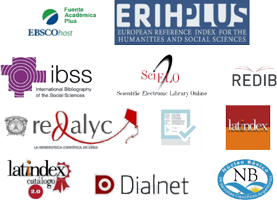Quais fatores influenciam a construção de cidades inteligentes? Um modelo multinível com dados em termos de cidades e países
Palavras-chave:
cidades inteligentes, TIC, modelos de regressão multinívelResumo
Nos últimos anos, o conceito de “cidades inteligentes” ou smart cities ganhou importância. É possível distinguir duas visões: a focada no papel das tecnologias da informação e da comunicação (TIC); e a que se estende a noções vinculadas ao crescimento econômico sustentável, a qualidade de vida, a governança participativa e a redução de emissões. Este trabalho tem como objetivo contrastar essas visões para analisar os fatores que incidem na construção de cidades inteligentes. Com base em uma amostra de 181 cidades em 81 países, estima-se um modelo de regressão multinível, com dados em termos de cidade e em termos de país. Os resultados obtidos mostram que o modelo tem um melhor ajuste na primeira visão: o nível econômico, o nível educativo, a localização na América Latina e o fato de serem cidades de países desenvolvidos em TIC são fatores que influenciam positivamente o nível de inteligência de uma cidade. Por outro lado, o modelo expresso em um sentido amplo mostra que quanto menor a taxa de desemprego urbana, maior o nível de inteligência das cidades.Downloads
Referências
ALBINO, V., UMBERTO, B. y DANGELICO, R. M. (2015): “Smart cities: definitions, dimensions, and performance”, Journal of Urban Technology, vol. 22, n° 1, pp. 3–21.
ANTHOPOULOS, L. y FITSILIS, P. (2010): “From Digital to Ubiquitous Cities: Defining a Common Architecture for Urban Development”, Proceedings of the 6th International Conference on Intelligent Environments IE10, Malasia, IEEE, pp. 301-306.
BELISSENT, J. y GIRON, F. (2013): Service Providers Accelerate Smart City Projects, Forrester Research Report, Cambridge, Forrester Publication.
CARAGLIU, A., DEL BO, C. y NIJKAMP, P. (2009): Smart Cities in Europe, 3rd Central European Conference in Regional Science, Košice, 7-9 de octubre.
CLAYTON, J. y MACDINALD, S. J. (2013): “The limits of technology”, Information, Communication & Technology, vol. 16, n° 6, pp. 945-966.
DEBNATH, A. K., CHIN, H., HAQUE, M. y YUEN, B. (2014): “A methodological framework for benchmarking smart transport cities”, Cities, vol. 37, pp. 47-56.
DE LA CRUZ, F. (2008): “Modelos Multinivel”, Revista Peruana de Epidemiologia, vol. 12, n° 3, pp. 1-8.
DIEZ ROUX, A. (2002): “A glossary for multilevel analysis”, Journal of Epidemiology and Community Health, n° 56, pp. 588-594.
FLORIDA, R. y MELLANDER, C. (2012): “The Rise of Skills: Human Capital, the Creative Class and Regional Development”, CESIS Electronic Working Paper Series, n° 266.
GIBSON, D. V., KOZMETSKY, G. y SMILOR, R. W. (1992): The technopolis phenomenon: Smart cities, fast systems, global networks, Lanham, Rowman & Littlefield Publishers.
GIFFFINGER, R., HAINDLMAIER, G. y KRAMAR, H. (2010): “The role of rankings in growing city competition”, Urban research & practice, vol 3, n°3, pp. 299-312.
GLAESER, E. L. y SAIZ, A. (2004): “The Rise of the Skilled City,” Brookings-Wharton Papers on Urban Affairs, pp. 47–94.
HOLLAND, R. (2008): “Will the real smart city please stand up?”, City: analysis of urban trends, culture, theory, policy, action, vol 12, n°3, pp. 303-320.
KITCHIN, R., LAURIAULT, T.P. y MCARDLE, G. (2015): “Knowing and governing cities through urban indicators, city benchmarking and real-time dashboards”, Regional Studies, Regional Science, vol. 2, n° 1, pp. 6-28.
LETAIFA, S. B. (2015): “How to strategize smart cities: reveleaing the SMART model”, Journal of business research, vol. 68, n° 7, pp. 1414-1419.
LUPIAÑEZ, F. y FAULÍ, C. (2017): “Ciudades Inteligentes: Evaluación social de proyectos de Smart Cities”, Centro de Estudios de telecomunicaciones de América Latina.
MARCEAU, J. (2008): “Introduction: Innovation in the city and innovative cities”, Innovation: Management, Policy & Practice, vol. 10, n° 2-3, pp. 136-145.
MORETTI, E. (2004): “Estimating the Social Return to Higher Education: Evidence from Longitudinal and Repeated Cross-Sectional Data,” Journal of Econometrics, vol. 121, pp. 175–212.
MUSTERD, S. y OSTENDORF, W. (2004): “Creative cultural knowledge cities: Perspectives and planning strategies”, Built Environment, vol. 30, n° 3, pp. 188–193.
NAM, T. y PARDO, T. A. (2011): “Smart city as urban innovation: focusing on management, policy and context”, ICEGOV2011, 26-28 de septiembre, Tallinn.
NEIROTTI, P., DE MARCO, A., CAGLIANO, A., MANGANO, G. y SCORRANO, F. (2014): “Current trends in smart city initiatives: some stylized facts”, Citie, vol. 38, pp. 25-36.
OCDE (2003): PISA 2003. Manual de análisis de datos, Madrid, OCDE.
ODENDAAL, N. (2003): “Information and communication technology and local governance: Understanding the difference between cities in developed and emerging economies”, Computers, Environment and Urban Systems, vol. 27, n° 6, pp. 585-607.
PARTRIDGE, H. L. (2004): “Developing a human perspective to the digital divide in the ‘smart city’”, en H. Partridge (ed.): Australian Library and Information Association Biennial Conference, 21-24 de septiembre, Gold Coast.
PASKALEVA, K. A. (2009): “Enabling the smart city: the progress of city e-governance in Europe”, Int. J. Innovation and Regional Development, vol. 1, n° 4, pp. 405–422.
RAUCH, J. E. (1993): “Productivity Gains from Geographic Concentration of Human Capital: Evidence from the Cities”, Journal of Urban Economics, vol. 34, pp. 380–400.
SHAPIRO, J. M. (2006): “Smart Cities: Quality of Life, Productivity, and the Growth Effects of Human Capital,” Review of Economics and Statistics, vol. 88, pp. 324–335.
STEINERT, K., MARON, R., RICHARD, P., VEIGA, G., y WITTERNS, L. (2011): “Making cities smart and sustainable. Global innovation index report”, pp. 87–95. Disponible en: https://www.globalinnovationindex.org/userfiles/file/GII-2011_Report.pdf.
TOPPETA, D. (2010): “The Smart City Vision: How Innovation and ICT Can Build Smart, ‘Livable’, Sustainable Cities”, The Innovation Knowledge Foundation.
WASHBURN, D., SINDHU, U., BALAOURAS, S., DINES, R. A., HAYES, N. M. y NELSON, L. E. (2010): “Helping CIOs understand ‘smart city’ initiatives: Defining the smart city, its drivers, and the role of the CIO”, Cambridge, Forrester Research, Inc. Disponible en: http://public.dhe.ibm.com/partnerworld/pub/smb/smarterplanet/forr_help_cios_und_smart_city_initiatives.pdf.
WEISI, F. y PING, P. (2014): “A discussion on smart city management based on meta-synthesis method”, Management Science and Engineering, vol. 8, n°1, pp. 68–72.
WEISS, M. et al. (2013): “Cidades inteligentes: casos e perspectivas para as cidades brasileiras”. Disponible en: http://www.altec2013.org/programme_pdf/1511.pdf
WINTERS, J. V. (2011): “Why are Smart cities growing: who moves and who stays”, Journal of Regional Science, vol. 51, n° 2, pp. 253-270.
ZYGIARIS, S. (2012): “Smart city reference model: Assisting planners to conceptualize the building of smart city innovation ecosystems”, Journal of the Knowledge Economy, vol. 4, n° 2, pp. 217–231.
Downloads
Publicado
Como Citar
Edição
Seção
Licença
Todas os números de CTS e seus artigos individuais estão sob uma licença CC-BY.
Desde 2007, a CTS proporciona acesso livre, aberto e gratuito a todos seus conteúdos, incluídos o arquivo completo da edição quadrimestral e os diversos produtos apresentados na plataforma eletrônica. Esta decisão é baseada no entendimento de que fornecer acesso livre aos materiais publicados ajuda a ter uma maior e melhor troca de conhecimentos.
Por sua vez, em se tratando da edição quadrimestral, a revista permite aos repositórios institucionais e temáticos, bem como aos sites pessoais, o autoarquivo dos artigos na versão post-print ou versão editorial, logo após da publicação da versão definitiva de cada número e sob a condição de incorporar ao autoarquivo um link direcionado à fonte original.











